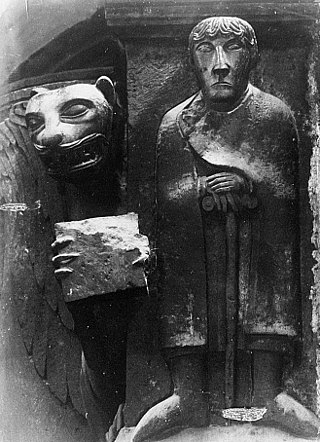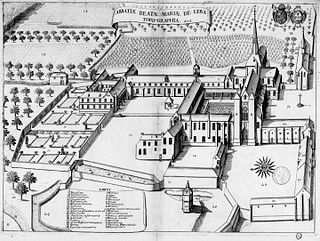The Antiphonary tonary missal of St. Benigne was written in the last years of the 10th century, when the Abbot William of Volpiano at St. Benignus of Dijon reformed the liturgy of several monasteries in Burgundy. The chant manuscript records mainly Western plainchant of the Roman-Frankish proper Mass and part of the chant sung during the matins, but unlike the common form of the Gradual and of the Antiphonary, William organized his manuscript according to the chant genre, and these sections were subdivided into eight parts according to the octoechos. This disposition followed the order of a tonary, but William of Volpiano wrote not only the incipits of the classified chant, he wrote the complete chant text with the music in central French neumes which were still written in campo aperto, and added a second alphabetic notation of his own invention for the melodic structure of the codified chant.

Fécamp is a commune in the northwestern French department of Seine-Maritime.

Bernay is a commune in the west of the Eure department in Northern France.

Jumièges Abbey was a Benedictine monastery, situated in the commune of Jumièges in the Seine-Maritime département, in Normandy, France.

Saint William of Volpiano was a Northern Italian monastic reformer, composer, and founding abbot of numerous abbeys in Burgundy, Italy and Normandy.

Philibert of Jumièges was an abbot and monastic founder, particularly associated with Jumièges Abbey.

Judith of Rennes (982–1017) was Duchess of Normandy from c. 1000 until her death.

Ouche Abbey or the Abbey of Saint-Evroul is a former Benedictine abbey in Normandy, located in the present commune of Saint-Évroult-Notre-Dame-du-Bois, Orne, Normandy. It has been classified as a Monument historique since 1967 and is designated "classé".

The Abbey of the Holy Trinity at Fécamp, commonly known as Fécamp Abbey, is a Benedictine abbey in Fécamp, Seine-Maritime, Upper Normandy, France.
Everdon Priory was a priory in Northamptonshire, England. The village of Everdon is located about 6 km south-east of the town of Daventry.

The Mont-Saint-Michel Abbey is an abbey located within the city and island of Mont-Saint-Michel in Normandy, in the department of Manche.

The Abbey of Saint-Sauveur-le-Vicomte, located in the commune of Saint-Sauveur-le-Vicomte in the Manche department of France, was a Benedictine monastery founded in the 11th century by Néel de Néhou, Vicomte of Saint-Sauveur. The abbey has longstanding connections with the nearby Channel Islands. After being dissolved in the French Revolution it became in the 1830s the mother house of the Sisters of Christian Schools of Mercy, now the Congregation of Saint Marie-Madeleine Postel.

Cerisy Abbey, otherwise the Abbey of Saint Vigor, located in Cerisy-la-Forêt, Manche, France, was an important Benedictine monastery of Normandy.

Lyre Abbey was a monastery in Normandy, founded in 1046 at what is now the village of La Vieille-Lyre. From the mid-12th century it was a Benedictine house. It was abolished at the French Revolution and the abbey buildings mostly destroyed.

Saint-Gabriel-Brécy Priory was a Benedictine priory 10 km from the coast between Caen and Bayeux. It is sited in the town of Saint-Gabriel-Brécy, Calvados, France. A 13th century gate-tower survives, with ogive vaulting on sculpted capitals. It was adjoined by a now-lost guesthouse. The cornice is sculpted with small three-point arches. The vaulted refectory dates to the late 13th century. A keep was built to serve as a prison in the 15th century, whilst the Renaissance-style courtroom was built towards the end of the 16th century. A dovecote is now lost.
Vitalis of Creuilly or Vitalis of Bernay was a Benedictine monk from Normandy. Sources on his life include the early 15th century history of the Abbey by John Flete and the 1751 An history of the Church of St. Peter, Westminster, commonly called Westminster Abbey by Richard Widmore.

Romanesque architecture appeared in France at the end of the 10th century, with the development of feudal society and the rise and spread of monastic orders, particularly the Benedictines, which built many important abbeys and monasteries in the style. It continued to dominate religious architecture until the appearance of French Gothic architecture in the Île-de-France between about 1140 and 1150.

Montivilliers Abbey is a former Benedictine nunnery, founded between 682 and 684 by Saint Philibert in the town of Montivilliers in Normandy, in the present department of Seine-Maritime, France. It was suppressed during the French Revolution, but many buildings, including the church, have survived.

Saint-Maur Abbey, originally called the Abbaye des Fossés, is a former abbey now subsumed in the Saint-Maur-des-Fossés suburb of Paris, France. The remains and the domain of the abbey have been transformed into a pleasure park named Parc de l'abbaye. The former abbey building has been replaced by a square at the corner of Avenue de Condé and Rue de l'Abbaye. Some ruins remain, such as the Rabelais tower, the 19th century Bourières villa and the old fortifications. The remains of the abbey have been classified as historical monuments since June 13, 1988.

Nicolas of Normandy was the fourth abbot of Saint-Ouen Abbey, Rouen.


















